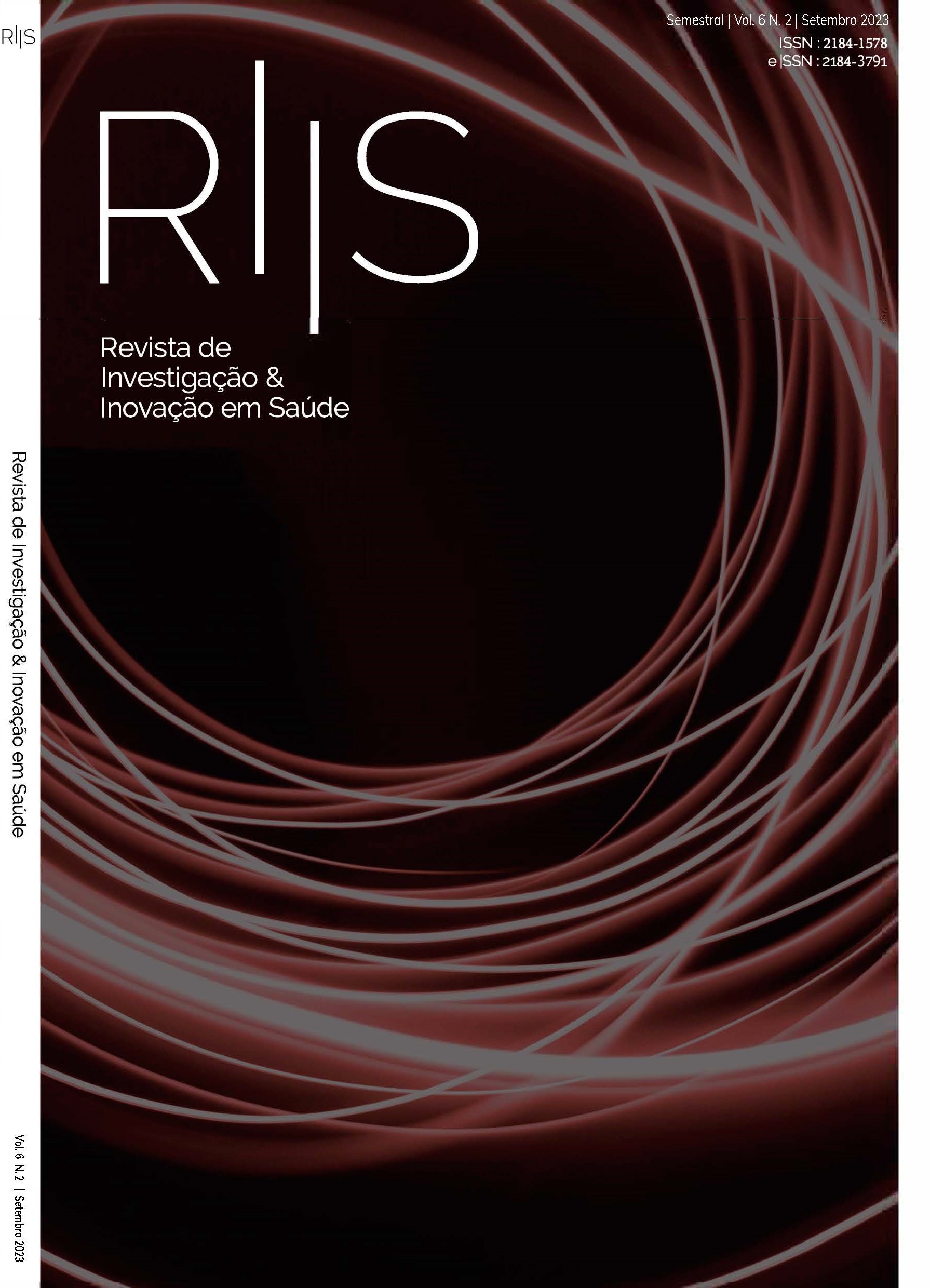Barreiras à higiene das mãos num serviço de urgência segundo os profissionais de saúde
DOI:
https://doi.org/10.37914/riis.v7i3.325Palavras-chave:
higienização das mãos, infeções hospitalares, serviço hospitalar de emergênciaResumo
Enquadramento: a higienização das mãos é considerada a medida mais simples e efetiva na redução de infeções associadas aos cuidados de saúde. Objetivos: analisar a perceção dos profissionais de saúde de um serviço de urgência acerca das barreiras às boas práticas de higienização das mãos. Metodologia: estudo quantitativo, descritivo, correlacional e transversal, desenvolvido num serviço de urgência médico-cirúrgica em Portugal. Recolha de dados com recurso a um questionário de caracterização sociodemográfico e à aplicação da escala “Barreiras à Adesão à Higiene das Mãos”. Participaram no estudo 153 profissionais de saúde. No tratamento dos dados foram utilizadas medidas de tendência central, medidas de dispersão, correlações, estudos da fiabilidade e teste de diferenças de médias. O estudo obteve parecer favorável por parte da Comissão de Ética da Unidade de Saúde. Resultados: a Avaliação & Feedback é a barreira mais valorizada, enquanto a Formação & Treino foi a menos relevante enquanto barreira à higienização das mãos. Constatou-se diferenças estatisticamente significativas em todas as variáveis sociodemográficas, com exceção do sexo. Conclusão: o conhecimento das barreiras às práticas de higienização das mãos permite identificar fragilidades. O envolvimento da liderança com a equipa é decisivo para a mudança de comportamentos.
Referências
Administração Central do Sistema de Saúde. (2021). Produção e Rácios de Eficiência. https://benchmarking-acss.min-saude.pt/MH_ProdRacioEficUrgenciaDashboard
Baek, E. H., Kim, S. E., Kim, D. H., Cho, O. H., Hong, S. I., & Kim, S. (2020). The difference in hand hygiene compliance rate between unit-based observers and trained observers for World Health Organization checklist and optimal hand hygiene. International journal of infectious diseases: IJID: official publication of the International Society for Infectious Diseases, 90, 197–200. https://doi.org/10.1016/j.ijid.2019.10.004
Belela-Anacleto, A. S., Peterlini, M. A., & Pedreira, M. D. (2017). Hand hygiene as a caring practice: a reflection on professional responsibility. Revista Brasileira de Enfermagem, 70(2), 442-445. https://doi.org/10.1590/0034-7167-2016-0189
Burnett, E. (2018). Effective infection prevention and control: the nurse's role. Nursing Standard, 33(4), 68-72. https://doi.org/10.7748/ns.2018.e11171
Chang, N. N., Schweizer, M. L., Reisinger, H. S., Jones, M., Chrischilles, E., Chorazy, M., Huskins, W. C., & Herwaldt, L. (2022). The impact of workload on hand hygiene compliance: Is 100% compliance achievable?. Infection control and hospital epidemiology, 43(9), 1259–1261. https://doi.org/10.1017/ice.2021.179
Costa, A., & Gaspar, P. (2017). Perfil de competências do enfermeiro no serviço de urgência. In M. Dixe, P. Sousa & P. Gaspar (Eds.), Construindo conhecimento em enfermagem à pessoa em situação crítica (1ª ed., pp. 49-67). Instituto Politécnico de Leiria. https://iconline.ipleiria.pt/bitstream/10400.8/2877/1/PSC_Ebook.pdf
Cunha, Q., Camponogara, S., Freitas, E., Pinno, C., Dias, G., & Cesar, M. (2017). Fatores que interferem na adesão às precauções padrão por profissionais da saúde: Revisão integrativa. Enfermagem em Foco, 8(72). https://doi.org/10.21675/2357-707X.2017.v8.n1.980
Direção-Geral da Saúde. (2017). Programa de Prevenção e Controlo de Infeções e de resistência aos antimicrobianos. https://www.sns.gov.pt/wp-content/uploads/2017/12/DGS_PCIRA_V8.pdf
Doutorado, C., Barros, D., Vasconcelos, R., & Santos, A. (2017). Survey on knowledge, attitude and hygiene practice of hands by nursing professionals. Revista de Enfermagem UFPE, 11, 1136-1145. https://dx.doi.org/10.5205/reuol.10544-93905-1-RV.1103201703
Graveto, J. M., Rebola, R. I., Fernandes, E. A., & Costa, P. J. (2018). Hand hygiene: nurses adherence after training. Revista Brasileira de Enfermagem, 71, 1189-1193. https://doi.org/10.1590/0034-7167-2017-0239
Grupo Coordenador Local – Programa de Prevenção e Controlo de Infeções e de Resistência aos Antimicrobianos. (2020). Relatório de Atividades. Centro Hospitalar do Tâmega e Sousa. EPE. GCL-PPCIRA
Issa, M., Dunne, S. S., & Dunne, C. P. (2023). Hand hygiene practices for prevention of health care-associated infections associated with admitted infectious patients in the emergency department: a systematic review. Irish journal of medical science, 192(2), 871–899. https://doi.org/10.1007/s11845-022-03004-y
Kim, J., Yu, S.N., Jeong, Y.S. Yu, S.N., Kim, J.H., Jeon, M.H., Kim, T., & Choo, E. J. (2023). Hand hygiene knowledge, attitude, barriers and improvement measures among healthcare workers in the Republic of Korea: a cross-sectional survey exploring interprofessional differences. Antimicrob Resist Infect Control, 12(1), 93. https://doi.org/10.1186/s13756-023-01296-y
Le, C., Lehman, E., Nguyen, T., & Craig, T. (2019). Hand Hygiene Compliance Study at a Large Central Hospital in Vietnam. International Journal of Environmental Research and Public Health, 16(4). https://doi.org/10.3390/ijerph16040607
Lien, T. Q., Johansson, E., Lan, P. T., Chuc, N. T. K., Thoa, N. T. M., Hoa, N. Q., Phuc, H. D., Tamhankar, A. J., & Lundborg, C. S. (2018). A Potential Way to Decrease the Know-Do Gap in Hospital Infection Control in Vietnam: "Providing Specific Figures on Healthcare-Associated Infections to the Hospital Staff Can 'Wake Them Up' to Change Their Behaviour". International journal of environmental research and public health, 15(7), 1549. https://doi.org/10.3390/ijerph15071549
Maroco, J. (2003). Análise Estatística com utilização do SPSS. Edições Sílabo
Oliveira, M., Menezes, L., Filho, J., Leite, M., Fernandes, L., Santos, A., Correia, K. (2019). Hand hygiene: knowledge and attitudes of healthcare professionals. Revista de Enfermagem UFPE, 13, 33-37. https://doi.org/10.5205/1981-8963.2019.236418
Pestana, M. H., & Gageiro, J. N. (2003). Análise de dados para ciências sociais: A complementaridade do SPSS. (3ªed.). Edições Sílabo.
Pisoeiro, Z., & Gaspar, P. (2014). Hand hygiene compliance. Barriers perceived by healthcare professionals. In P. Sousa, F. Serranheira & A. S. Uva (Eds.), Livro de proceedings do 4º Congresso Internacional de Qualidade em Saúde e Segurança do Doente (1ª ed., pp. 201-210). Congresso Internacional de Qualidade em Saúde e Segurança do Doente. https://www.researchgate.net/publication/262663695_Hand_hygiene_compliance_Barriers_perceived_by_healthcare_professionals
Puro, V., Coppola, N., Frasca, A. et al. (2022). Pillars for prevention and control of healthcare-associated infections: an Italian expert opinion statement. Antimicrobial Resistance & Infection Control, 11, 87. https://doi.org/10.1186/s13756-022-01125-8
Saiz, C. (2020). Pensamiento Critico y Eficácia. (2ª ed.). Pirámide.
Seo, H. J., Sohng, K. Y., Chang, S. O., Chaung, S. K., Won, J. S., & Choi, M. J. (2019). Interventions to improve hand hygiene compliance in emergency departments: a systematic review. Journal of Hospital Infection, 102(4), 394-406. https://doi.org/10.1016/j.jhin.2019.03.013
Shim, J. Y., Park, S., Kim, G. E., Jeong, Y. S., Kim, J. H., Lee, E., Lee, E. J., Kim, T. H., & Park, S. Y. (2019). Does Physician Leadership Influence Followers' Hand Hygiene Compliance?. Open forum infectious diseases, 6(6), ofz236. https://doi.org/10.1093/ofid/ofz236
Silva, J. K., Matos, E., & Souza, S.S. (2020). Care bundle for both prevention and control of hospital-acquired infection in adult emergency service. Revista de Pesquisa Cuidado é Fundamental Online, 12, 176–182. https://doi.org/10.9789/2175-5361.rpcfo.v12.7192
Thandar, M. M., Rahman, M. O., Haruyama, R., Matsuoka, S., Okawa, S., Moriyama, J., Yokobori, Y., Matsubara, C., Nagai, M., Ota, E., & Baba, T. (2022). Effectiveness of Infection Control Teams in Reducing Healthcare-Associated Infections: A Systematic Review and Meta-Analysis. International journal of environmental research and public health, 19(24), 17075. https://doi.org/10.3390/ijerph192417075
Trannin, K., Vancini-Campanharo, C., Lopes, M., Okuno, M., & Batista, R. (2016). Adesão à higiene das mãos: intervenção e avaliação. Cogitare Enfermagem, 21. https://doi.org/10.5380/ce.v21i2.44246
World Health Organization. (2009). Guidelines on Hand Hygiene in Health Care. First Global Patient Safety Challenge Clean Care is Safer Care. WHO. http://apps.who.int/iris/bitstream/handle/10665/44102/9789241597906_eng.pdf?sequence=1
World Health Organization. (2011). Report on the Burden of Endemic Health Care-Associated Infection Worldwide. WHO. https://iris.who.int/bitstream/handle/10665/80135/9789241501507_eng.pdf
World Health Organization. (2021). Draft Global Patient Safety Action Plan 2021-2030. WHO. https://www.who.int/teams/integrated-health-services/patient-safety/policy/global-patient-safety-action-plan
Yadav, S. K., Semwal, R. S., Piyush, A., & Nath, B. (2019). Knowledge, attitude and perceived barriers of doctors towards hand hygiene in a govt. tertiary care hospital. Journal of Preventive Medicine and Holistic Health, 5(2), 91–98. https://doi.org/10.18231/j.jpmhh.2019.018
Downloads
Publicado
Como Citar
Edição
Secção
Licença
Direitos de Autor (c) 2024 Filomena Silva, Pedro Costa, Fátima Braga, Silvana Martins

Este trabalho encontra-se publicado com a Licença Internacional Creative Commons Atribuição 4.0.















